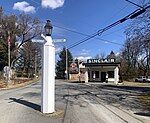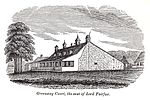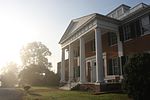Lucky Hit
Clarke County, Virginia geography stubsFederal architecture in VirginiaHouses completed in 1791Houses in Clarke County, VirginiaHouses on the National Register of Historic Places in Virginia ... and 4 more
Meade family of VirginiaNational Register of Historic Places in Clarke County, VirginiaPlantation houses in VirginiaShenandoah Valley, Virginia Registered Historic Place stubs

Lucky Hit is one of the oldest brick houses in southwestern Clarke County, Virginia. The double-pile (i.e. two rooms deep), central hallway house was built by Colonel Richard Kidder Meade around 1791, and was named by Meade in his belief that he had made a fortunate choice in his property. He previously resided at the log house Meadea. His children, including Bishop William Meade and Ann Randolph Meade Page, who were raised on this plantation established plantations nearby; many of the historic houses remain today. This property stayed in the Meade family until 1869.It was listed on the National Register of Historic Places in 1993.
Excerpt from the Wikipedia article Lucky Hit (License: CC BY-SA 3.0, Authors, Images).Lucky Hit
Geographical coordinates (GPS) Address Nearby Places Show on map
Geographical coordinates (GPS)
| Latitude | Longitude |
|---|---|
| N 39.056111111111 ° | E -78.0925 ° |
Address
22663
Virginia, United States
Open on Google Maps










